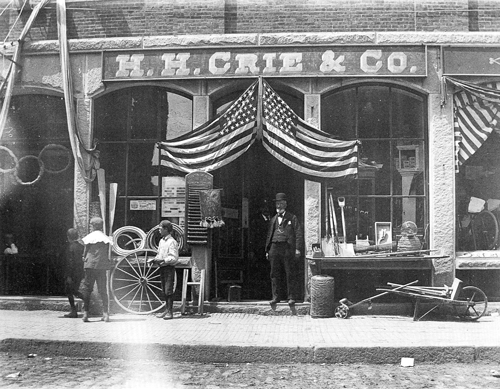B A C K T H E N
Doing Well While Doing Good

About 1900. Hiram H. Crie stands in the doorway of his hardware store, a Rockland institution established in 1859. Maine people then depended on hardware stores for the necessities of weekday, rather than weekend, work. A hardware dealer could do well while doing good, and in 1888 Crie, doing very well indeed, did $100,000 worth of business.
Many country stores—also company stores owned by mills, quarries, shipbuilders, and the like—grew fat at the expense of an entrapped clientele. Crie, on the other hand, was located in a growing transportation hub, and prospered from the mobility of his customers. Local demand, from the lime, granite, and shipbuilding industries, and from coopers, cottage-builders, fishermen, and farmers, was considerable. Added to this was the business brought by the hundreds of visiting kiln-wood schooners, many from New Brunswick, and by Rockland-based lobster smacks which freighted supplies to isolated fishermen from the Penobscot to the Bay of Fundy. Tilson’s Wharf was patronized by packet schooners connecting various islands, local steamers, and big steamers running to Boston and Down East. Towns to the southwest were linked to Rockland by rail.
Taking inventory at Crie’s was an all-hands evolution. On shelves, in barrel and bin, hanging from racks and hook from cellar to loft, and in “commodious storehouses” located about the city, were to be found blacksmith stock and tools, carriage stock, ship chandlery, fishermen’s outfits, quarry stock and tools, guns and ammunition, chain, fencing, wire cable (samples are displayed on a board by the door), oakum, boat nails and rivets, putty and paint, oils, varnishes, glass, cobbler kits, shoe stock, iron and steel, groceries, general hardware, and other items far too numerous to list. Just as general stores in the country accepted eggs, butter, wool, potatoes , shingles, ax handles, and other such pro duce in trade, Crie’s accepted fish oil, dried hake sounds, and likely anything else that would find a ready market.
Periodic refits brought in hardscrabble lobster catchers from the Muscle Ridge, island fishermen, back-country farmers, coopers and hoop-pole makers, stone cutters, quarrymen, and other horny-handed denizens of the coastal hinterlands. Poet Wilbert Snow’s father, Forrest, served at the LifeSaving Service Station at White Head Island, Spruce Head, in the ’80s:
Payday with its check of $125 came four times a year. As soon as it arrived and my father had his day off from the Coast Guard station, he went by mail stage to Rockland. Reaching home at night, he was loaded down with manila rope, nails, secondhand books, shell-loading tools, and fishing tackle—some of which he could not afford to buy. Many of these items he bought at a store called H. H. Crie’s. Another store he patronized was H. H. Stover’s. When he came home without bringing his wife anything pretty, she would upbraid him and accuse him of running into debt at H. H. Crie’s, H. H. Stover’s, H. H. Dondi’s, H. H. Tuttle’s—and rattle off a list of H. H.’s that nobody ever heard of.
The Rockland Courier-Gazette says two vessels arrived at that port last week from Swan’s Island, one with twenty people aboard and the other with fifty, on their annual visit for the purpose of purchasing their winter supplies. The vessels were loaded with fish, hides, yarn, mittens, stockings, etc., which were bartered for all kinds of supplies, dry goods, hardware, provisions, etc. The advent of the Swan’s Islanders is quite an event in the life of the Rockland merchants, their arriving giving for the time a very busy season. Another vessel-load of seventy-five is expected.
—The Maine Mining & Industrial Journal, Dec. 7, 1883.
Hiram Hall Crie was a native of Criehaven on Ragged Island, one of the low-lying ocean sentinels of lower Penobscot Bay. One of twelve children, his grandfather had taken French leave from the British Army at Castine. Asked late in life the secret to his success, he replied that he never indulged in speculation. The photo was taken by his daughter-in-law, Ida Shepherd Crie, one of a number of artful and proficient Maine women photographers of the era.
The bunting draped above the doorway evidently honors the Glorious Fourth. Crie’s patriotically advertised cheap cast-iron blank-shooting pistols, blank cartridges, and black powder for the consideration of holiday celebrants. In July 1882 twelve year-old Eben Rivers of Owl’s Head died a terrible death by lockjaw, caused by a toy pistol. He was the twenty-fifth New Englander (most were boys) to die since that July 4th of tetanus infection attributed to slight injuries caused by percussion-cap toy pistols. Maine law later banned both the selling and giving away of such toy pistols.
Note the handsome use of cut granite on the street level of the brick building. The sidewalk is paved with brick. Granite blocks pave the street, once reputed to be the muddiest in the stat—one spring, it was said, a boat was rowed the length of it.
Text by William H. Bunting from A Days Work, Part 1, A Sampler of Historic Maine Photographs, 1860–1920, Part II. Published by Tilbury House Publishers, 12 Starr St., Thomaston, Maine. 800-582-1899.
